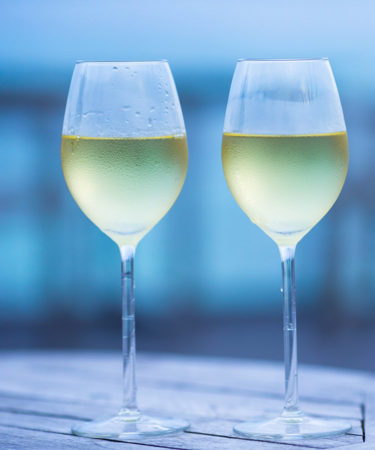You know those really, really hot summer days when you unconsciously turn the AC down to, like, winter-level temperatures? When you turn your room or apartment into a mini-fridge because you’re kinda pissed at the sun, and then about two hours into your chilly victory, you realize you’re shivering?
Well, that’s what we’re all doing to white wine. Not that we’re angry at it (who could be angry at Chardonnay? Seriously.). But that old directive “serve red wine room temp, white wine chilled” stuck in our brains like freezer burn to the top of delicious ice cream, and most of us haven’t broken the habit of not only chilling, but over-chilling, all manner of white wines. It’s Pinot Grigio, not vodka. Give it a break from the fridge. Or at least a cardigan.
Before we get into the right temperatures, just a reminder why we refer to a “right temperature” for wine at all. Just like with beer, temperature-serving guidelines vary depending on the kind of wine you’re pouring, the goal being to maximize flavor perception. If you’re having a heavy red wine, you’ll want it closer to (but not at) room temperature. If you’re having a super-crisp Sauvignon Blanc, you’ll want it colder (but not Elsa-level icy). Certain temperatures just better-accentuate the characteristics of different wines, everything from body to acidity to — and here’s where it’s really important — aromatics.
See, when you over-chill a white wine, you’re essentially giving it a Frosty the Snowman bear hug, clutching in its aromatic compounds with excessive cold, meaning they can’t waft up toward your nostrils and share the delicious notes of lychee or lemon grass or honeydew melon. (And yes, to the haters and red-wine-ride-or-die crew, white wine has plenty of complex aromatics to share.)
Not to imply you’re doing it on purpose. When we buy white wine, we all tend to stick it directly into the fridge, even if we’re not drinking it immediately. (We’ve all had those depressing moments when we realize the white wine is lukewarm on the counter (not that we’re above chucking in an ice cube.) And most refrigerator temperatures land somewhere in the upper 30s range, which is only a few ticks above snowfall. Like Winter Wonderland, crystallization-of-atmospheric-water-and-dust-particles snowfall. Way too cold for white wine.
Way too cold for sparkling wine, in fact. Whatever your bubbly desires, it should be served at a range closer to 40 to 50 degrees. The best range for white wines is 50 to 60 degrees, more than 20 degrees warmer than the way most of us typically serve it. Of course, there’s wiggle room — a few degrees give or take. And, of course, different white wines have different optimal serving temps. The basic rule of thumb: crisper and more acidic wines are better a bit colder, toward the 50-degree side of the spectrum. An oakier or richer wine (something that’s gone through some malolactic fermentation, maybe?) will do better at the other end of the spectrum.
Again, personal taste reigns supreme. If you like your Chardonnays straight from an ice bucket filled with liquid nitrogen, go for it. But if you want to get the most character out of your white wines — and they’ve probably been bustin’ to share their hidden talents with you for a while now — don’t serve them straight from the fridge. Let them rest on the counter 10 minutes before serving time. Use that 10 minutes to reflect on how white wine-savvy you are.
